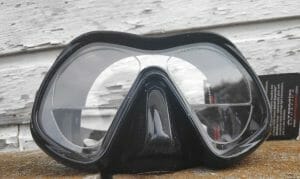13th July 2020
Prescription dive mask concerns for photographers and cinematographers
One of my personal passions, since I started scuba diving at 14 has remained underwater photography. Being able to share images and videos of the sites we are so privileged to be able to see as divers starting with my old 35mm camera and housing I took on my early dives. Some of us divers from a young age need help with our vision and use of underwater camera equipment, while others have vision issues that develop with age. In addition to various vision issues that can affect diver’s ability to use a camera, photographers and cinematographers have unique needs that every mask may not fit.
For example on the right, is an OTS Spectrum full face diving mask used by a professional photographer. Only reading lenses were used and were made oversize so the photographer could focus on their camera and settings, with a little space left on top for uncorrected distance viewing.
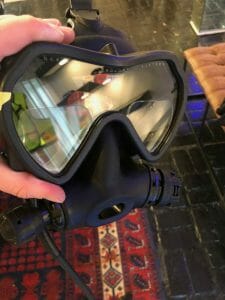
In this article, am going to discuss scuba masks and prescription mask concerns as they relate to the underwater photographer including:
- Picking a mask for underwater photography
- Prescription lens options
- Reading lens options
Picking a (prescription or corrective) scuba mask for underwater photography:
While photography needs (and prescription needs) do affect mask decision, it is still important to not forget the basics. While a mask may be one of the less expensive pieces of equipment a diver uses, few things can ruin a dive like a mask that fogs, leaks, or completely fails. A quality dive mask should consist of a silicone skirt, tempered glass lenses, and high quality frame materials (if not frameless). This becomes even more critical when trying to capture the once in a lifetime shot through your viewfinder only to later find your focus was off due to a foggy mask
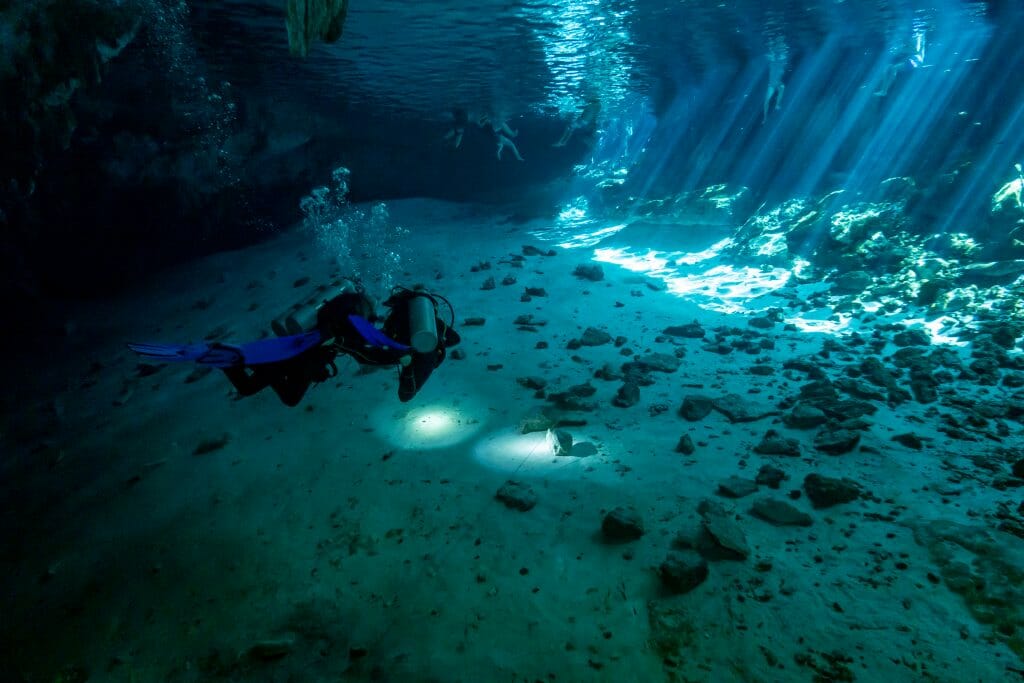
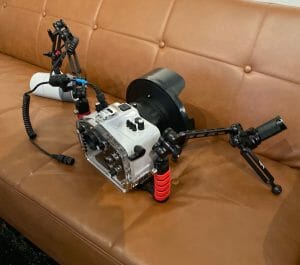
Modern digital cameras and software allow us to save a lot of images in post processing, but focus cannot be repaired in post (there is always an exception, such as the dual pixel raw Canon 5DmkIV which allows MICRO focus adjustments in Canon software).
On the left is my 5DMKIV housing which fits the full size DSLR. While the dual pixel raw image does allow some focus shifting in post, it is extremely minor and will not fix an out of focus image but rather is designed to sharpen focus on the eyes for example.
In addition to general mask concerns, photographers do have a few additional needs.
To minimize any distortion of lcd viewfinders or monitors, underwater photographers should avoid tinted or mirrored lenses. While tinted and mirrored dive mask lenses are popular with recreational divers to bring back color while diving or cut through glare at the surface, any mirror or tinted lens does reduce the amount of light reaching the eye. As underwater photographers, we want every photon to reach our eyes, so we can see the clearest picture and ensure we are capturing what we would like.
In my article on choosing a prescription dive mask, one of the larger decisions we have to make when choosing a new dive mask is whether we want a clear skirt or a black skirt mask. Clear skirts let in some peripheral light but tend to yellow over time while black skirts look newer longer. As underwater photographers, the glare from side skirts can be distracting, so in general we recommend black skirt dive masks for photography.
The decision as to whether to use a twin lens or single lens dive mask makes no difference and is a personal choice.
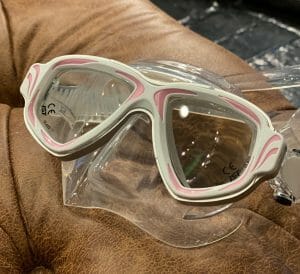
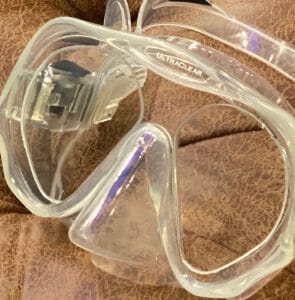
Prescription considerations for the underwater photographer
In general, there are three main lens styles for prescription dive masks:
- Single Vision/Distance Correction Lenses
- Reading Lenses
- Bifocals
Single vision lenses correct for one distance only , and wee refer to single vision lenses for distance only correction. For divers that only need correction for distance due to issues such as myopia or astigmatism (yes we can even create prism lenses for scuba diving ).
If a professional underwater photographer has very mild distance correction, they often choose to not correct for the distance so as to keep the near vision as clear as possible.
Single vision lenses start at $208.00.
Reading lenses correct for close vision due to issues such as presbyopia. For the underwater photographer, who spends considerable more time using near/close vision for reviewing camera settings, camera monitors, and viewfinders, reading lenses can be the most popular option. Photographers require larger reading lenses than a diver who just needs to be able to see their gauge or computer. One of our most popular masks for reading lenses is the Atomic Venom Frameless with Reading glass.
Reading lenses start at $158.99.
Bifocal lenses are the most popular lenses produced at See the Sea. Bifocal lenses correct for both near and far distances. I wrote a much longer article (which includes a video about bifocals) on bifocal dive masks which you can review here. While many advanced underwater photographers forgo distance correction in order to focus on their close vision, if your distance vision is poor enough the dive quality would be diminished without it, there are two main and one fully custom bifocal options to consider.
Above is a Scuba Pro Synergy II Twin dive mask (one of our more popular masks), with one of our standard bifocal options. With both our standard bifocal options (the ST28 and the St38), the lens is divided into two sections: A large distance correction area as well as a half moon near vision correction zone. If you look closely at the picture above, you can see the line separating the areas. The final size of the near correction area is a factor of the dive mask, your pupillary distance, and lens constraints. The St35 (starting at $315) is the preferred standard bifocal for photographers as the near vision area is approximately 25% larger than on the St28.
For photographers that cannot operate their equipment with the constraints of the half moon near correction zone, our fully custom bifocal, the Franklin bifocal, pictured below, allows us to use two separate lenses per eye providing a truly custom product with the amount of distance/near correction per eye determined by the scuba diver/ photographer. As this is a fully custom product, online ordering is not available. Please call us for more information.
As seen with the Atomic Venom Frameless mask above with Franklin lenses, there are two lenses per eye with the near vision lenses at the bottom of the mask extending all the way across, not limited to a half moon shape. Further the percentage of lens for each eye dedicated to near versus far vision can be determined by the diver while consulting us.
other considerations and ordering
Some prescriptions limit mask choices, such as those with high plus lenses or high prism generally find our M100 and M200 dive masks to work best due to the space between the lenses and the diver’s face. Other dive issues such as freediving photographers, may prefer a low volume mask. I wrote an article on some of our low volume masks for freediving here.
If you are ready to order a prescription dive mask, you can go to our order page here. If you have any questions, you can also click the chat box on the bottom right which comes to us during business hours (and often forwards to one of our cellphones after hours). You can also call us at the office at 1800-356-7190.
As always, you also can send us your own quality dive mask to have lenses installed, and do not have to get a dive mask directly from us. We also have a network of dealer dive stores across the United States ready and willing to help you pick a mask for prescription lenses from See the Sea.

Josh
Josh is an optical technician and owner of See the Sea RX. He is a PADI instructor and has been involved in diving for more than 20 years. He has also worked as a sergeant at the Harris County, Texas, Sheriff's Office, which included time as the instructor for the dive team. Josh also holds a masters degree in data analytics from Texas A&M.
